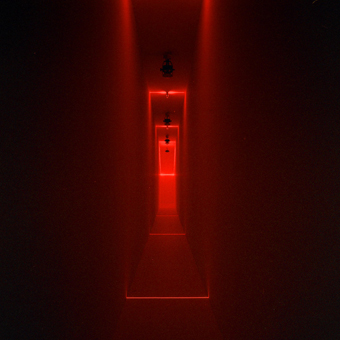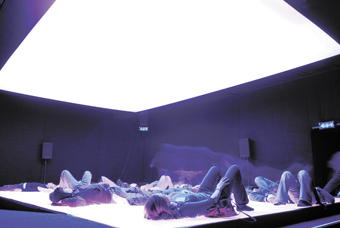 |
Ryoji Ikeda, Spectra II |
Certain of Ikeda’s previous compositions on CD can be said to resemble nothing so much as a ‘concerto for electric cattle-prod’, and the surges that accompany every burst of light in Spectra II are highly reminiscent of these angry crackling stabs. It has the emotional effect of urging you on up the corridor, into the unknown. At the same time, the prospect of what lies at the end of the walkway is not exactly comforting; everything has the air of an horrific science fiction landscape, the laser lines in the distance forming the crosshairs for some terrible inhuman device.
As you move tentatively forward, the clashing sine waves about you form peaks and troughs in your geographic perception where peaks and troughs have no right to be. If you clap your hands, it doesn’t reflect back off the walls in the normal fashion and is instead swallowed up by some sort of ambient compression. In short, ladies and gentlemen, this is hell. Everything is consumed by the insatiable space, and it’s never, ever going to stop.
So, yeah, it’s a bit of a disappointment when you get to the far end of the corridor and it’s just a straightforward wall. A laser marker is slapped across it just above eye level, and the red glow renders wood grain within the construct highly visible, removing any mystery about its provenance. For a while you feel like knocking on the wood just to see if it will open up, continuing beyond, a further corridor, onward into infinity. But no such luck.
The fact that this is a finite corridor necessarily makes Spectra II a game of 2 halves, and the last trick up Ikeda’s sleeve is revealed when you turn to retrace your steps. In returning back down the passageway, you are blocking the principle light source, the laser. In addition to this, your exit far off in the distance is only vaguely lit by the half-light spilling from the outside world. As each strobe explosion occurs, it’s now far more apparent that the walls of this corridor are painted bright white, which means your funny little brain does a funny little thing: in the sudden absence of light (an effect you can mimic anytime by quickly shutting your eyes) the brain converts any after-image held by the retina into a negative of itself. This means, that in the final part of Spectra II, you are traversing a space that seems to be repeatedly vanishing into complete nothingness in controlled bursts. Hell isn’t going to let you go easy.
 |
Alex Bradley & Charles Poulet, White Plane_2 Adam Farady |
There are further associations: having to remove your shoes gives the experience a sepulchral edge, alongside the deep, reassuring roar of a gong that drops in and out of the ambient noise... Some of the colours bleach the environment so as to suddenly turn everyone upon the platform to monochrome.
Whilst a crowd of primary school children is in residence, the space turns into a wash of blue and without prompting, the kids all begin to swim like fish. Whilst Bradley and Poulet must in some sense have programmed a limited combination of instructions into Whiteplane_2’s software, the foreground presence of an audience extends the aesthetic possibilities into almost infinite territories. Some people chatter, some lie prone, some throw paper aeroplanes, some stare at their feet throughout. If you’re willing to be in the space for long enough, you can play a strange little game of crowd control, so that if you sit on the ground for long enough eventually everyone will be sitting; if you lie staring at the ceiling, you rise some time later to see that the platform looks like a bed-in, bodies prone, blissed-out. So unlike Spectra II, which after the fact one recalls as a ‘ride’, a sort of futuristic ghost train, Whiteplane_2 can be so many other things all at once: a toy, an escape, an artwork, a moment. And it’s all thanks to the audience. Jean-Paul Sartre was wrong. Hell is a solitary pursuit. Heaven is other people.
Ryoji Ikeda began his career as composer for Japanese multimedia performance company Dumb Type. Since 1995 he has been internationally active in sound art through concerts, installations and recordings.
Sound engineer and multi-skilled technician Charles Poulet has developed relationships with artist and their projects, inspiring his own creative art practices. Poulet explores feelings and emotions through the physicality of sound, raising questions about how we inhabit spaces both as individuals and groups.
Alex Bradley has been a practising artist since 1989, specialising in performance, audio and digital technologies. Alongside solo and collaborative projects he has undertaken contracts for project management and consultancy using his expertise in emergent technologies.
Spectra II, Ryoji Ikeda, The L-Shed; Whiteplane_2, Alex Bradley and Charles Poulet, This Secret Location, Arnolfini, Feb 1- 12
Tim Atack is a musician, performer and writer living and working in Bristol. His band angel tech can be found at www.angeltech.co.uk/
© Tim Atack; for permission to reproduce apply to [email protected]








 back
back